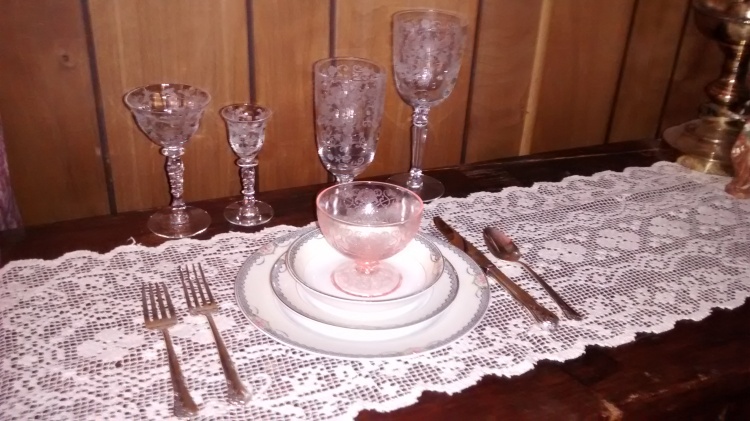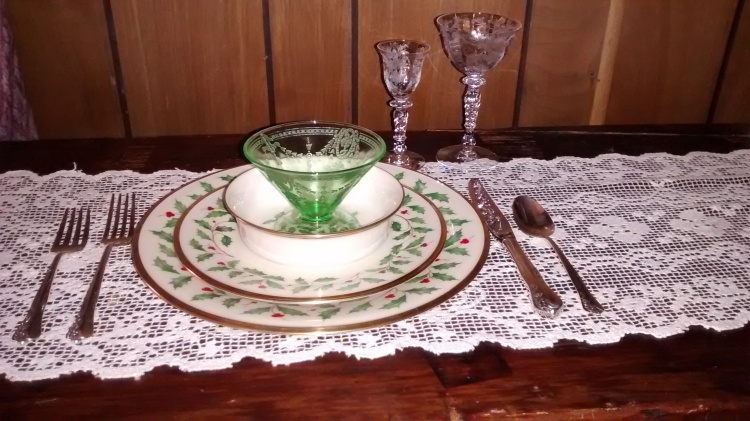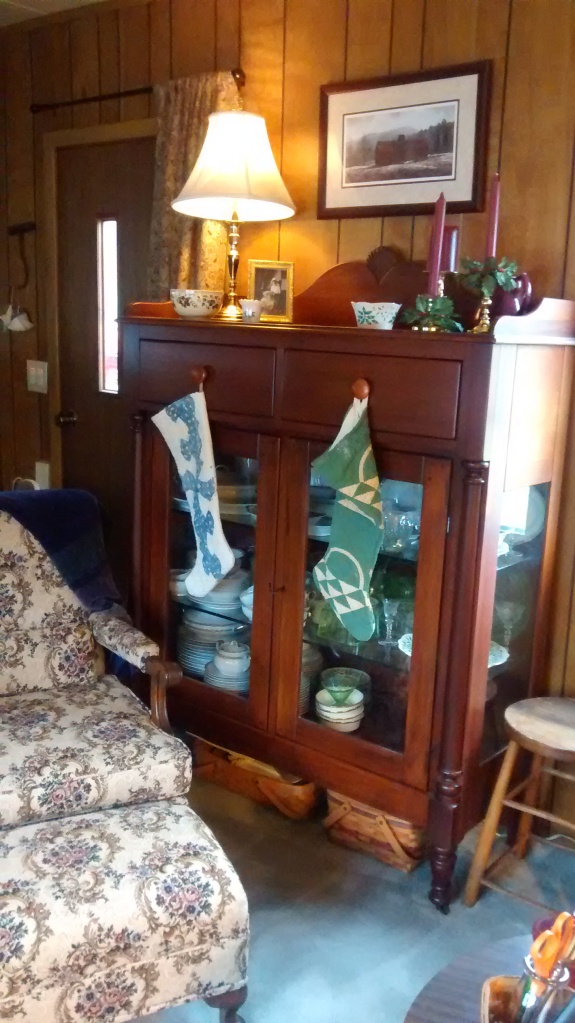Yes, you read the title correctly. True, this is not the typical thing I write about, nor are china and crystal something one might expect to find in a single-wide, vintage 1972 trailer, at the bumpy end of a dirt farm road on what was once a pasture adjacent to an old, fallen-down barn. When a person envisions “Wild, Wonderful, West Virginia,” images tend to be of a more outdoorsy theme – narrow waterfalls cascading over ledges of bedrock, old log cabins standing guard in a now-deserted meadow, fishermen casting for trout in the North Fork River.

Pictured above is Noritake “Deerlodge” china, pink Depression glass sherbet and, from left to right in the back, Tiffin “Byzantine” liquor cocktail, Tiffin “Byzantine” cordial, and two unidentified etched crystal pieces, also Goodwill discoveries for 99 cents each!
Yet glass production is part of the Mountain State’s heritage. Blenko, Fenton, Fostoria, Hazel-Atlas, Morgantown, Seneca Glass, and Weston Glass, are just a few of the companies that called West Virginia home. Production skyrocketed in the state between 1900-1940. As tastes in glass products changed, West Virginia’s glass companies kept up with their consumers’ demands. Pressed glass, blown glass, colored glass, crystal, etched pieces all emerged from the state’s numerous factories.
China and pottery manufacturers made their home among the mountains as well. Perhaps the most well-known company is the Homer Laughlin China Company, which relocated from one side of the Ohio River to the other, to Newell, West Virginia, around the turn of the twentieth century. Here, the company was able to expand its operations to meet the growing demands of the market. And after 1927, when Frederick Hurten Rhead was hired as design director, Homer Laughlin would need ALL those new facilities. Rhead was responsible for designing Fiestaware, the company’s most prolific line of pottery. During World War II, production lines were churning out pottery needed for the military. But after the war ended, Fiesta’s consumer lines resumed and continued to grow in popularity; Fiestaware helped Homer Laughlin reach its peak production year in 1948.
Following the war, imported china began to encroach on the markets of U.S.-based companies. It was difficult to compete with these china lines because they were priced so economically. Of course, labor costs overseas were considerably lower compared to those of American products. Many domestic china factories simply could not compete and were forced out of business.
But not Homer Laughlin! Company directors saw what was happening in the industry and switched gears a bit. They’d always had commercial lines of china which catered to motel, hotel, and restaurant industries. Homer Laughlin decided to put increased emphasis in this area and ease off on the production of china for the home. Their strategy worked and kept them afloat during very difficult times for less far-sighted companies.
However, the Fiestaware line was eventually phased out, stopping production of the colorful pieces completely in 1973. But Fiesta lovers are a loyal and determined bunch! (I hear cheers in the distance!) Popular demand from fans of the china helped bring back the line in 1986; this time, the glazes used on the ware were lead-free. This met with approval from environmentally-minded consumers as well as those with young children. Folks with a taste for nostalgia and those who loved the clean, bright designs of the china were more than happy to add Homer Laughlin’s Fiestaware to their kitchens.
China was not the only thing adorned with Fiestaware’s Art Nouveau shape and crayon box colors. Table linens, silverware, colanders, refrigerator magnets, napkin holders, picture frames, all sorts of items drew styling and colors from Fiesta.
When I was a girl, I loved eating at Grandma Powers’ home. She had the original, lead-glaze Fiestaware (somehow, I survived meals in Medina) and it was always a much-anticipated surprise to see what combination of colors she’d use to set the breakfast or lunch table. It was fun to have an ever-changing array of dishes – we didn’t have all those colors at home! Grandma also had these sort of oddly-shaped glasses that seemed to perfectly complement the Fiesta. I remember the glasses having a curvy shape, wider at the base than at the top, a thick base, and fairly thin. Like the Fiesta, the glasses were different colors, changing the tint of a glass of milk from blue to green to pink, depending on the hue of the glass.
About five years ago, I was slowly cruising the aisles of my favorite Northern Virginia Goodwill. I’d do that several times a week, using it as a sort of physical therapy following my car accident. It sure beat heading to a gym or therapist’s, which was out of the question for me, and the items on the shelves there were constantly changing. I used to hang onto one of those small-scale grocery carts; they were light enough for me to push and maneuverable enough to make my way through the store with ease. There was always something new to look at, always something really unusual to check out, occasionally an object that made me wonder why anyone would have purchased it to begin with, and when I needed to sit, there was always a couch or chair to rest upon.
On this particular day, I spied a familiar shape nestled among objects in the orange-colored section at Goodwill. It was a Fiestaware “Tangerine” cup and saucer – 99 cents each! Feeling nostalgic, I added it to my cart. Then, it dawned on me that there were probably more cups and saucers, in different colors, hiding among other stuff. So I checked out each section, delighted to add “Periwinkle Blue”, “Sea Mist Green”, and “Yellow” (a pale, creamy color) to the first cup and saucer.
Bringing that colorful Fiesta home was such a treat for my eyes. It was as if Grandma was there, sharing a meal at my home. The cheerful colors also helped lift my sagging spirits. That began a pursuit of Fiesta china in other spots, too. I eventually ended up with about 8 place settings of the pastel colors. I loved using them. So did my son. And when I needed to downsize prior to moving, he asked if he could have the Fiesta. I gladly gave my collection to him, thinking how the china would be a little taste of home, a bit of nostalgia, as he transferred wherever the military needed him.
I gave most of my Lenox “Holiday” china to my youngest daughter, who insisted I keep four settings for myself. (So glad she did!) I’d fallen for the classic pattern when I was just 15; Mom and Dad gave me my first “Holiday” cup and saucer when I turned 16. I do love the “Holiday” but I am happy to know it will be put to good use in its new home! However, I could not bear to part with a single piece of Grandma Powers’ antique Noritake and the memories that come with it. I just love using that china and I do not save it for “special days”. My three children used to take it out of the china hutch v-e-r-y carefully first thing in the morning on Mother’s Day and set the table with it. Even the youngest member of the family knew how to handle the china. He may have growled like a tiger at times (really, he did, it was embarrassing), but he was as gentle as a kitten with his great-grandma’s dishes!

Pictured above are Lenox “Holiday”, green Depression glass sherbet, and in the back, Tiffin “Byzantine” cordial and liquor cocktail.
Now, those dishes reside in a mahogany reproduction dining chest in the front room of our home. I can – and do – access them frequently to use on the table in the kitchen. There’s no dining room, no dining room table here. But that won’t stop me from enjoying those dear old plates! Sometimes, I’ll serve fruit and yogurt in pink Depression glass that goes nicely with the Noritake Deerlodge pattern. My newest additions – 10 pieces of Tiffin etched crystal – look right at home with Grandma Powers’ china. She would’ve approved!

This is my “treasure chest” – a mahogany reproduction dining chest. Doesn’t it look like it’s an antique? I just love it! The barn print above it is by David Knowlton; prints of his paintings adorn the walls of our home. Yes, that is a tapestry curtain over the front door; it’s very heavy and quite effective at keeping out drafts! We hung its mate across the entrance to the hallway, in this same room. Those drapes greatly improved our comfort last winter! Both stockings were made by a talented eBay seller from old “cutter” quilts. The gold-framed photograph near the lamp shows my maternal grandmother, Alma Ramming, on her wedding day in 1926. The chair is from her home, but I’ll have to save its story for another time!
I’ve heard that people are increasingly reluctant to purchase china or glassware that needs to be hand washed. Such a shame! Perhaps that’s why it’s been relatively painless to find some great bargains on antique china and crystal. Grandma Ramming used to say, “Tea tastes better from a china cup.” I quite agree. Last fall, I found six pieces of Tiffin etched, optic crystal stemware in the “Byzantine” pattern at a Goodwill store. I have loved etched crystal since I was a girl, when my grandmother would set her formal dining room table with pink-and-clear etched crystal. Now I had no idea, when I spied it at Goodwill, who’d made the crystal I’d come across or what it might be worth. I just knew I loved it and I wanted to set my table with that etched crystal stemware and Grandma Powers’ old Noritake china! Fortunately, the asking price was something I could afford – 99 cents each. So I took home four cordials and two liquor cocktails, washed them up, and have loved and used them since. I don’t drink alcoholic beverages, but eggnog – just about anything! – tastes better when I drink it from one of those gleaming pieces of stemware! FarmerHoney gifted me with four juice glasses in the same pattern for Christmas, and I keep them nearby in the kitchen. It’s a little thing, a simple pleasure. But to have juice from vintage crystal first thing in the morning is a wonderful way to start the day!
Unlike contemporary trends, I do not find it a hassle to hand wash china or crystal. It gives me more time to enjoy each piece. On the other hand, it IS a hassle hand washing everyday china (also Noritake). My kitchen attests to that fact at the moment! (And no, I am not about to photograph my messy kitchen. You’ll just have to take my word that it’s really, embarrassingly untidy!) I had been doing just fine until we’d run out of dishwasher pods for our portable little dishwasher and well, it’s just amazing how quickly dishes pile up!
Hmm…maybe I should simply bring the formal china and etched crystal into the kitchen and use them all the time. It might be a better way for me to keep the kitchen clean!

(Audible sigh from author…) Looking through these pictures has given me the inspiration needed to start tackling the state of my home! This is our dishwasher, a purchase I resisted but one that FarmerHoney was smart enough to make anyway. It holds everything we need to clean for over a single day’s use. It’s designed to accommodate a lot of dishes in a small space. There’s also a spot for water softener salt – we need that, we have well water. This little dishwasher is so much quieter than any dishwasher I have ever used. Typically, my hands dry out and my fingertips crack each winter from doing dishes – but this wonderful machine saved my hands this winter. I love it!
What an enjoyable article about your Grandma and her China. My grandmother came to America from Scotland after high school. She taught me to only drink tea from a China cup (pronounced ‘cheena’ cup with her brogue) ! What wonderful memories you have shared ! Thank you.
Sounds like our grandmothers had something in common, Mary! Mine was born in Barry, Ontario and moved when she was a child to Newfane, New York where her carpenter father found work. Being Canadian, Grandma loved her cup of tea! Another holdover from Canada was her expression when urging her daughters to clean house each Saturday, “Clean as if the Queen was coming for a visit!”
It is sweet when the things we treasure are precious because of the beloved memories of dear people that are associated with them. I have China and crystal that I also treasure for the same reasons as you – because, in addition to simply being beautiful, they remind me of my mother, aunts, grandmothers. Thank you for sharing your story. I enjoyed it.
One of my most-treasured items was a set of simple measuring spoons purchased at an estate sale in El Paso, Texas. They were the same style as the measuring spoons my Grandma Ramming used. She taught me how to bake pie and every time I used those spoons, it was as if she was there with me in the kitchen. It’s nice to be surrounded by love!
One of my most-treasured items was a set of simple measuring spoons purchased at an estate sale in El Paso, Texas. They were the same style as the measuring spoons my Grandma Ramming used. She taught me how to bake pie and every time I used those spoons, it was as if she was there with me in the kitchen. It’s nice to be surrounded by love!
I think there’s material for a good story in those measuring spoons!
Sandra, thank you for sharing your home and memories. I really enjoyed reading this and wished I were sitting with you enjoying a cup of tea from one of the china teacups! Again, thank you.
Thank you, Teri! I wish you were here, too. Well, maybe not just this very minute as we’d struggle to find a spot on the kitchen table to rest our tea cups! But you know, you are within about 4 hours of Seneca Rocks, and it would make an awesome extended weekend trip. There’s camping, hiking, fishing, beautiful scenery. I never knew West Virginia was so incredibly gorgeous. So, if you get the hankering for a road trip, let me know and I’ll be sure to bake some cookies to go along with our tea!